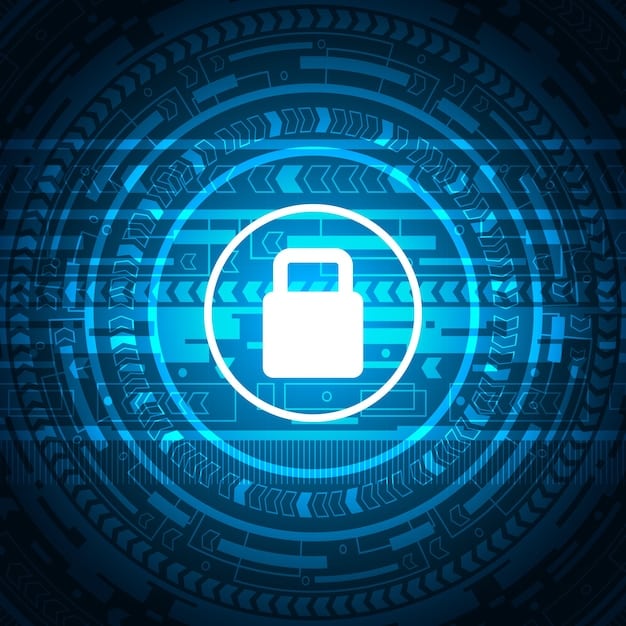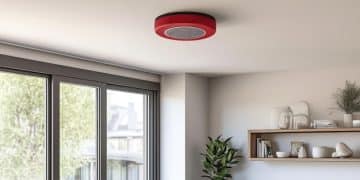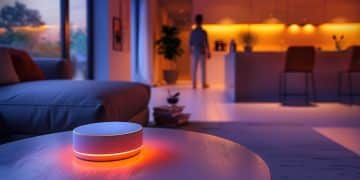Voice Assistant Privacy: Secure Your Smart Home Data in 2025

Anúncios
Navigating voice assistant privacy in 2025 requires proactive steps to protect personal data, ensuring your smart home remains a secure and private sanctuary rather than an open book.
As our homes become increasingly intelligent, powered by conversational AI, the convenience of voice assistants clashes with inherent privacy concerns. Understanding Voice Assistant Privacy: 3 Steps to Secure Your Smart Home Data in 2025 is no longer optional but a critical necessity for every connected household.
Understanding the Evolving Landscape of Voice Assistant Privacy
The rapid evolution of smart home technology, particularly voice assistants, has transformed daily routines, offering unparalleled convenience through simple voice commands. From controlling lighting and thermostats to managing shopping lists and playing music, these devices have become integral to modern living. However, this seamless integration comes with a trade-off: the constant collection and processing of personal data. As we move into 2025, the depth and breadth of data gathered by these devices are expanding, encompassing not just spoken commands but also ambient sounds, usage patterns, and even biometric information in some advanced systems. This expansion significantly amplifies the privacy stakes, necessitating a deeper understanding of how our information is handled.
The Data Collection Spectrum
Voice assistants, such as Amazon Alexa, Google Assistant, and Apple Siri, are sophisticated pieces of technology designed to learn and adapt to user preferences. To achieve this, they continuously collect various forms of data. This includes direct voice commands, which are recorded and sent to cloud servers for processing and interpretation. Beyond explicit commands, these devices may also capture contextual audio, inadvertently picking up conversations, background noises, and other sounds within the home environment. The implications of this continuous listening range from minor inconveniences to significant privacy breaches, depending on the sensitivity of the information captured and how it is subsequently used or stored. Furthermore, interaction data, such as the types of questions asked, services accessed, and devices controlled, builds a comprehensive profile of user habits and preferences. This profile can then be used for personalized experiences, but also for targeted advertising or, in more concerning scenarios, shared with third parties.
- Voice Commands: Explicit commands spoken by users for device activation and function.
- Contextual Audio: Background sounds and conversations inadvertently picked up by always-on microphones.
- Usage Patterns: Data on device interaction frequency, time of use, and types of services accessed.
- Device Interconnections: Information shared between the voice assistant and other smart home devices.
Regulatory Frameworks and Their Limitations
While governments and regulatory bodies are striving to catch up with the pace of technological advancement, the existing legal frameworks often lag behind the complex realities of data privacy in the smart home. Regulations like GDPR in Europe and CCPA in California have set precedents for data protection, granting users more control over their personal information. However, these regulations are not universally applied, leaving many consumers in other regions with less protection. Even where strong regulations exist, the burden of understanding and exercising these rights often falls on the individual user. Companies, while adhering to minimum legal requirements, may still design their services in ways that encourage maximum data collection, often burying critical privacy settings within complex menus or obscure terms and conditions. The global nature of data storage and processing also adds a layer of complexity, as data may be transferred across borders with differing privacy standards.
The evolving landscape of voice assistant privacy in 2025 demands a proactive approach from consumers. It is not enough to simply trust that manufacturers and service providers will prioritize user privacy. Instead, users must take deliberate steps to understand the data collection practices of their devices, configure settings to limit information sharing, and remain vigilant about new privacy tools and best practices. This foundational understanding sets the stage for the specific actions one can take to secure their smart home data, moving beyond passive acceptance to active control.

Step 1: Audit Your Devices and Understand Data Practices
The first crucial step in safeguarding your smart home data in 2025 is to conduct a thorough audit of all your voice-activated devices and meticulously understand their respective data collection practices. Many homeowners accumulate smart devices over time without fully grasping the extent of information each gadget gathers. This initial investigative phase is paramount, as different manufacturers and service providers have varying approaches to data privacy, often detailed in lengthy and complex terms of service agreements. A comprehensive inventory is the starting point for effective privacy management.
Inventorying Your Smart Devices
Begin by compiling a complete list of every smart device in your home that incorporates voice assistant technology or relies on voice commands. This goes beyond the obvious smart speakers like Amazon Echo or Google Nest. Consider smart TVs with built-in voice assistants, smart thermostats, security cameras, smart light bulbs, and even smart appliances that respond to voice. For each device, identify the manufacturer, the specific model, and the primary voice assistant platform it utilizes. A clear inventory provides a roadmap for your privacy audit, allowing you to systematically address each potential data collection point.
- Identify all voice-enabled devices: List every smart speaker, TV, thermostat, and appliance.
- Note manufacturer and platform: Understand which company and voice assistant (e.g., Alexa, Google Assistant) are involved.
- Document current settings: Record initial privacy configurations before making changes.
- Assess network connections: Understand how each device connects to your home network and the internet.
Deciphering Privacy Policies and Terms of Service
This is perhaps the most challenging, yet most vital, part of the audit. Each device and its associated service will have a privacy policy and terms of service document. These legal texts outline what data is collected, how it is used, with whom it is shared, and for how long it is retained. While daunting, it is imperative to at least skim these documents, focusing on sections related to data collection, third-party sharing, and data retention. Pay close attention to clauses that permit personalized advertising, data aggregation, or sharing with affiliates. Look for information on how you can access, rectify, or delete your data. Several online tools and communities now exist that summarize or simplify these agreements, which can be invaluable resources. Understanding these policies empowers you to make informed decisions about whether to keep a device, how to configure its settings, or if necessary, replace it with a more privacy-centric alternative.
The depth of data collection can vary significantly. Some devices may only record commands when actively prompted by a wake word, while others might continuously listen for patterns or background speech, even if not explicitly sending it to the cloud. Understanding these nuances is critical. For instance, a smart camera might offer local storage options, reducing reliance on cloud processing, while a smart speaker might require all voice commands to be processed remotely for accuracy. By undertaking this meticulous audit, you establish a baseline understanding of your smart home’s data footprint, making it possible to move to the next step of configuring settings effectively. This proactive deep dive into your device ecosystem is the bedrock of robust voice assistant privacy in 2025.
Step 2: Optimize Privacy Settings and Data Retention
Once you have a clear understanding of which devices are collecting what data, the next critical step is to actively optimize their privacy settings and manage data retention policies. Many voice assistants come with default settings that prioritize convenience and functionality over strict privacy, often enabling extensive data collection by default. Taking the time to navigate these settings and customize them to your preferences is essential for bolstering your smart home’s data security. This step is about transitioning from passive user to active data guardian.
Configuring Voice Assistant Privacy Settings
Every major voice assistant platform—Alexa, Google Assistant, Siri, and others—provides a dedicated privacy dashboard or settings menu. It is crucial to access these and systematically review each option. Key settings to look for include:
- Voice Recording Retention: Most platforms allow you to review and delete past voice recordings. More importantly, they often offer options to prevent future recordings from being saved or used for product improvement. While turning off recording retention might slightly degrade the assistant’s performance over time (as it learns less from your specific commands), it significantly enhances privacy.
- Managing Third-Party Skills/Apps: Voice assistants integrate with numerous third-party applications and “skills.” Each of these can have its own data access permissions. Regularly review and revoke permissions for skills you no longer use or those that request excessive access to your data.
- Personalized Advertising: Look for settings that allow you to opt out of personalized ads based on your voice assistant interactions. While this might not stop data collection entirely, it limits how that data is monetized or used for targeted marketing.
- Wake Word Sensitivity: Adjusting wake word sensitivity can reduce instances where the device accidentally “wakes up” and records conversations when not explicitly addressed.
- Guest Access: If multiple users interact with the device, ensure guest or family profiles are configured with appropriate privacy levels, preventing one user’s activities from inadvertently affecting another’s privacy settings or data.
Beyond the main voice assistant, remember to check settings within individual smart home devices (e.g., smart cameras, doorbells, thermostats). Many of these have their own microphones and sensors, and thus their own privacy configurations regarding audio and video recording, data sharing with their respective manufacturers, and cloud storage. It’s not uncommon for a smart camera to have separate audio recording settings from its video, for instance.
Implementing Data Retention and Deletion Strategies
Data retention policies determine how long your recorded interactions and associated data are stored on company servers. While some data is necessary for the device to function effectively (e.g., processing a command in real-time), persistent storage of historical data poses a long-term privacy risk.
Actively set up automatic deletion schedules where available. For example, Google Assistant allows you to automatically delete activity data older than 3, 18, or 36 months. Amazon Alexa provides similar options. Regularly reviewing and purging historical data minimizes the risk of your information being compromised in a data breach or accessed without your consent in the future. Consider manually deleting data periodically, even if automatic deletion is enabled, for an extra layer of assurance. This regular data hygiene significantly reduces your digital footprint and enhances your overall voice assistant privacy in 2025. Remember, prevention is better than cure; optimizing settings proactively is far more effective than reacting to a privacy incident.
Step 3: Beyond Basic Settings – Advanced Protection Strategies
While auditing your devices and optimizing their privacy settings are crucial, advanced protection strategies offer an additional layer of security for your smart home data. These steps go beyond the typical app settings, focusing on network-level controls, physical management of devices, and adopting a privacy-centric mindset. In 2025, a truly secure smart home integrates these advanced considerations into its foundation.
Network-Level Security and Device Isolation
Your home network is the backbone of your smart home, and securing it is paramount. Many voice assistant devices communicate with cloud servers, often sending recorded audio or data for processing. Implementing network-level security can mitigate risks associated with this communication.
Firstly, ensure your home Wi-Fi network uses strong, unique passwords and WPA3 encryption where available. Regularly update your router’s firmware to patch security vulnerabilities. More advanced users can consider network segmentation, also known as creating a “guest” or “IoT” network. By isolating smart home devices on a separate network segment, you prevent them from directly accessing or compromising other personal devices on your main network (like computers, smartphones, or financial data). If one IoT device is breached, the attacker is contained within that specific segment, significantly limiting potential damage.
- Strong WiFi Encryption: Use WPA3; maintain strong, unique passwords.
- Regular Router Updates: Keep firmware current for security patches.
- Network Segmentation (IoT Network): Isolate smart devices on a separate network.
- Firewall Configuration: Adjust router firewall settings to restrict outbound data for certain devices.
Another consideration is using a Virtual Private Network (VPN) on your router. While a VPN primarily encrypts internet traffic and masks your IP address, a router-level VPN can ensure all traffic originating from your smart home devices (including voice assistants) is encrypted before it leaves your network, adding an extra layer of privacy from your Internet Service Provider and other potential eavesdroppers. However, implementing a VPN on a router can be complex and may affect performance.
Physical Device Management and Disconnection Habits
Sometimes, the simplest solutions are the most effective. Physical control over your voice assistant devices offers an undeniable level of privacy.
Microphone Mutes: Most smart speakers come with a physical mute button for the microphone. Make it a habit to use this button whenever you are not actively using the voice assistant, especially during sensitive conversations or when entertaining guests. This hard disconnection ensures no audio is being picked up, processed, or sent to the cloud, regardless of software settings. It’s a fail-safe against software bugs or accidental activations.
Powering Off: For devices with known privacy vulnerabilities or when you are away from home for extended periods, simply unplugging them can be the most effective measure. This completely cuts off their network connection and power, preventing any data collection or remote access.
Strategic Placement: Consider where you place your voice assistants. Positioning them away from private areas like bedrooms or bathrooms, and in common areas where their use is intended, can limit the scope of unintended audio capture. If a device has a camera, ensure its field of view does not include sensitive areas or consider physically covering the camera when not in use.
Adopting a Privacy-Centric Mindset
Ultimately, securing your smart home data in 2025 relies on cultivating a continuous awareness and skepticism about technology. This means regularly checking for software updates for all your smart devices, as manufacturers often release patches for newly discovered privacy or security vulnerabilities. Stay informed about news and developments in smart home privacy, as new threats or best practices emerge constantly.
Be mindful of the information you share verbally around your voice assistants. Even with robust privacy settings, accidental disclosures can occur. Teach all members of your household, particularly children, about respectful and secure interaction with smart devices. By combining technical safeguards with mindful usage habits, you build a resilient defense against the evolving challenges of voice assistant privacy, transforming your smart home into a truly secure and private environment. This holistic approach ensures that technology serves you, rather than vice versa, offering both convenience and peace of mind.
| Key Action | Brief Description |
|---|---|
| 📊 Audit Devices | Systematically list all voice-activated gadgets and understand their data practices and privacy policies. |
| ⚙️ Optimize Settings | Configure privacy controls, manage recording retention, and limit third-party access on all devices. |
| 🔒 Advanced Security | Implement network segmentation, utilize physical mute buttons, and develop a privacy-aware mindset. |
| 🔄 Stay Updated | Regularly check for software updates and stay informed about new privacy tools and best practices. |
Frequently Asked Questions About Voice Assistant Privacy
Most voice assistants are designed to listen for a specific “wake word” (e.g., “Alexa,” “Hey Google”). They only begin actively recording and sending audio to cloud servers for processing after detecting this word. However, “accidental” activations can occur, leading to unintended recordings of background conversations. You should always be aware of microphone mute functions.
Yes, all major voice assistant providers offer tools to review and delete your past voice recordings. You can usually find these options within the companion app or web portal for your device. It is highly recommended to regularly delete these recordings or set up automatic deletion schedules to enhance your privacy.
Voice assistants can enhance security by integrating with alarm systems or smart locks. However, they pose privacy risks due to constant listening for commands and collecting usage data. This data, if not managed properly, can be misused, accessed by unauthorized parties, or even used for targeted advertising. It’s a balance between convenience and data exposure.
Network segmentation involves setting up a separate Wi-Fi network, often called an “IoT network” or guest network, specifically for your smart home devices. This isolates them from your main personal network, minimizing the risk of a breach in a smart device compromising your more sensitive devices like computers or smartphones connected to the primary network.
There’s a growing trend towards “edge processing,” where more voice command interpretation happens directly on the device rather than in the cloud. This could significantly improve privacy by reducing the amount of personal audio sent to company servers. However, regulations and consumer demand will be key drivers in pushing for more privacy-centric features in the future.

Securing Your Smart Sanctuary: A Proactive Approach
In an increasingly connected world, the convenience offered by voice assistants in our smart homes is undeniable. Yet, this convenience brings with it significant questions about privacy and data security. As we navigate 2025 and beyond, it’s clear that the onus of protecting sensitive personal information collected by these devices largely falls upon the individual homeowner. By systematically auditing your devices, meticulously optimizing their privacy settings, and implementing advanced network and physical security strategies, you can transform a potentially vulnerable smart home into a fortified digital sanctuary. This proactive and informed approach ensures that your voice assistant serves you, enhancing your life without compromising your invaluable privacy.





